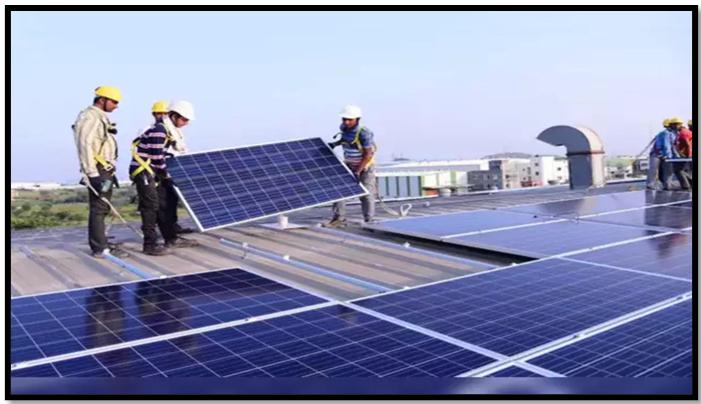SOLAR PANEL MANUFACTURING NORMS RELEASED
Syllabus:
- GS-2-India and its bilateral relations
- GS-3-Renewable energy and self dependent system
Focus :
- The Ministry of New and Renewable Energy (MNRE) implemented an executive order named “The Approved Models and Manufacturers of Solar Photovoltaic Modules (Requirements for Compulsory Registration) Order, 2019” from April 1, 2019.
Source- ET
Context of the Executive Order:
- This order requires solar module manufacturers to undergo inspections of their manufacturing facilities by the National Institute of Solar Energy to be listed as approved manufacturers.
- Being on the approved list certifies a company as a legitimate manufacturer of solar panels, distinguishing them from mere importers or assemblers.
- India’s solar industry heavily relies on imports of solar modules from countries like China, despite claims of indigenous production.
| Solar Technologies ;
1.Solar Photovoltaic (SPV) technology – It involves the conversion of solar radiation (sunlight) into electricity through specialized cells. These cells, typically composed of silicon and other semiconductor materials, generate electrical energy when exposed to sunlight. 2.Solar Thermal Power systems- Alternatively referred to as Concentrating Solar Power systems, harness concentrated solar radiation to serve as a high-temperature energy source for electricity generation. |
Reasons for India’s Reliance on Imports:
- India’s solar industry faces limitations in producing solar cells and modules, with a significant portion of the raw materials also being imported.
- The dominance of China in the global supply chain, accounting for nearly 80% of solar components, contributes to India’s reliance on imports.
- India’s ambitious plans to source a significant portion of its electricity from non-fossil fuel sources by 2030, especially solar power, necessitate substantial imports to meet demand.
- Diplomatic tensions between India and China further highlight the need to reduce dependence on Chinese imports.
Importance of Being on the Approved List:
- The primary advantage of being on the approved list is the eligibility to participate in government tenders for solar energy programs, such as the PM Surya Ghar Muft Bijli Yojana and PM KUSUM.
- Only domestic manufacturers listed as approved can compete for tenders and subsidies under various government schemes.
- The Production Linked Incentive Scheme aims to incentivize domestic manufacture of solar panels and components, with eligibility tied to being a genuine local manufacturer.
| Schemes to promote Solar energy :
1. PM SURYA GHAR YOJANA- Through this initiative, the central government will invest ₹75,000 crores to give its recipients 300 units of free electricity every month. Its goal is to light up one crore homes. Urban Local Bodies and Panchayats would receive incentives under the initiative to encourage rooftop solar systems within their respective jurisdictions. 2.PLI scheme– In an effort to draw in Rs 94,000 crore in investment for the “national programme on high efficiency solar PV modules,” the Union Government launched a Rs 19,500 crore production linked incentive (PLI) scheme. |
Assessment of India’s Manufacturing Capacity:
- Despite recent opportunities resulting from reduced exports from China to other countries, India’s solar industry still faces challenges.
- The demand-supply gap persists, with nearly half of India’s solar modules still being imported from China.
- While the number of certified manufacturers on the Approved Models and Manufacturers (AMM) list has increased, there is still no list for manufacturers of solar cells, indicating a continued reliance on imports.
Future Prospects and Challenges:
- The Indian government anticipates a significant rise in manufacturing capacity in the coming years.
- Uncertainties remain regarding the future of Indian exports, especially if the US decides to roll back duties on Chinese imports.
- Achieving self-reliance in solar module manufacturing requires addressing the demand-supply gap and enhancing domestic production capabilities.
Conclusion:
- The executive order implemented by the MNRE aims to incentivize domestic solar module manufacturing and reduce India’s reliance on imports, especially from China.
- While progress has been made with the increase in certified manufacturers, challenges such as the demand-supply gap and uncertainties in global trade dynamics persist.
- Achieving self-reliance in solar module manufacturing is crucial for India’s renewable energy goals and requires concerted efforts from both the government and industry stakeholders.
Source:The Hindu
Mains Practice Question :
GS-3
- ” Analyze the factors contributing to India’s reliance on solar module imports and assess the effectiveness of government initiatives in promoting domestic manufacturing. What are the key challenges and opportunities for achieving self-reliance in solar module production in India?”(250 words)




